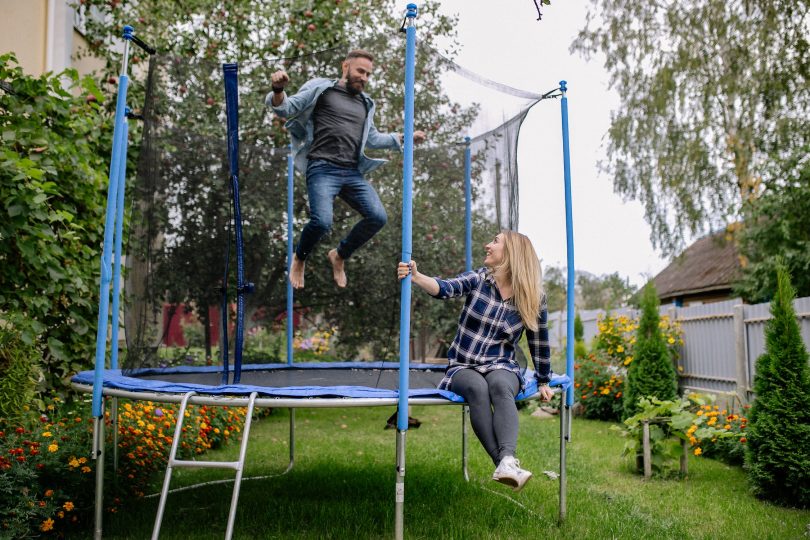There are over 100 varieties of arthritis, so calling it one disease is incorrect. Arthritis is the top U.S. disability. Some kinds of arthritis are more frequent in elderly adults.
Arthritis is the gradual, debilitating loss of joint motion due to the breakdown of articular cartilage over time. Since cartilage no longer acts as a shock absorber, the underlying bones are more strained.
When arthritis progresses to this point, the bones in the joint begin to rub against one another. That’s why you are in so much agony and can’t move about.
In the 1980s, when high-intensity aerobic exercises were all the rage, rebounding gained popularity. The practice has had a significant revival in recent years. It has been reported that rebounding is a very effective treatment for arthritic pain.
Let’s explore this notion in detail.
What Is Rebounding?
Rebounding is a kind of exercise that is performed on a tiny trampoline. Every rebounding session will center on the same piece of equipment, but no two sessions will be the same.
Using a fitness trampoline while rebounding has several advantages. It should be included in people’s regular workouts. Rebounding benefits the bones, endurance, and leg muscles.
These exercises are popular because they are gentle on the joints and beneficial for a healthy lifestyle.
With these trampolines, you can do dancing, muscle training, Pilates, and even yoga-based rebounding courses. You can consider doing weight loss exercises at home.
Choose the kind of rebounding that best suits your fitness needs and goals while still getting in a reasonable amount of bouncing.
What Is Arthritis?
Arthritis affects more people than any other joint illness. Arthritis symptoms include swelling, pain, stiffness, and joint stiffness. The severity and duration of symptoms might fluctuate.
The severity of certain symptoms may remain constant for quite some time, while that of others may worsen. Walking and climbing stairs may become very painful and exhausting for those with severe arthritis.
Likewise, arthritis may result in lasting alterations to the joints. Knobby finger joints are easy to observe, but X-rays are needed to assess the damage. Arthritis may affect more than just joints; it can also disrupt organs and systems.
Typical Arthritis Forms
Osteoarthritis
This kind of arthritis affects most individuals. Excessive usage causes “wear and tear” on your joints. The most prevalent reason is old age, although joint injuries or being overweight may also play a role.
Weight-bearing joints are particularly susceptible, including the knees, hips, feet, and spine. It usually develops over months to years. Joint pain is a common symptom. It doesn’t help you to experience healthy aging. The sickness and exhaustion associated with other forms of arthritis are absent here.
Rheumatoid Arthritis
Autoimmune illness best describes RA. This indicates that the body’s immune system is attacking healthy tissue, most notably the joints. This causes inflammation, which, if left untreated, may lead to irreversible joint damage.
Rheumatoid nodules are skin lumps that develop in around 20% of persons with rheumatoid arthritis. They tend to appear on the knuckles, elbows, and heels since they are pressure points.
Psoriatic Arthritis
Psoriasis and joint inflammation are symptoms of this illness (arthritis).
Psoriasis manifests as scaly, reddened, elevated patches of skin. Typically, it appears on the skin surrounding the anus, vaginal region, navel, and the ends of the elbows and knees.
Psoriatic arthritis is a rare complication of psoriasis, affecting only roughly 10%-30% of those with skin conditions.
Gout
Uric acid crystal formation in a joint. It’s usually the big toe or some other area of the foot.
Lupus
Systemic lupus erythematosus, more often known as lupus, is an autoimmune disorder. It may cause problems with various bodily systems, including your joints.
Reasons to Use a Small Trampoline to Treat Arthritis
1. For Osteoarthritis
Patients with osteoarthritis may exercise more on a small trampoline than on any other fitness equipment.
If you need assistance getting on or off the apparatus, just ask for it. It’s OK to take your time. It takes repeated attempts before the body can handle extended periods on a fitness trampoline. Once you have practiced, you can fast-hop for about 10 minutes or more.
2. Rheumatoid Arthritis and Rebounding
Damage to the joint’s cartilage over time leads to arthritis. It’s painful and severely restricts movement. As a consequence, less intense workouts and exercises are required physically and mentally.
Rheumatoid arthritis is characterized by functional impairment, pain, and weariness. Due to patient-specific and healthcare provider-related difficulties, clinical training interventions get delayed.
Rebounding with mini fitness trampolines at home can account for a good physical workout in such cases. Rebounding improves lymphatic circulation, which eliminates waste and white blood cells.
In arthritis, inflammation and pain are brought on by a buildup of white blood cell debris in the joints. A trainer as an encouraging training partner might help you break the pain cycle by introducing low-impact exercises.
Using a rebounder helps your body build resilience by exposing it to periods of high and low stress.
Other Benefits of Rebounding

Jumping on a mini-trampoline is fun, no question about it. However, the advantages of rebounding exercises extend well beyond mere amusement. It reduces stress on the musculoskeletal system and improves balance.
1. Positive Influence on Workout
Are you tired of sitting around and wishing you could get in shape without running? The trampoline will absorb each bounce, making the whole exercise soft on your joints even if it leaves you exhausted.
2. Increases stamina
Rebounding requires a fair amount of strength. As a result, your legs and core must work hard to keep you balanced and upright as you jump. If you attend a strength training and rebounding class, your muscles train to work much harder.
3. Natural Face Lift
This workout’s higher G force strains each body cell often. Cell membranes get thicker, stiffer, and more elastic over time.
4. Boosts Stamina
Staying healthy is a long-term commitment to oneself. You will have to try many things to have a healthy lifestyle. Without stamina, you won’t be able to possess graceful healthy aging.
Mini-trampoline exercises can get the blood flowing to every part of your body. Rebounding courses, like HIIT or dance, enhance heart rate and endurance.
5. Enhances Equilibrium and Coordination
Trampoline surfaces make it difficult to maintain a static position. Standing on that soft surface while working out is a sure way to improve your equilibrium and coordination.
6. Asthma
Asthma patients have trouble with athletic activities requiring quicker heart rates and deeper breaths. Asthmatics may feel better when rebounding since it utilizes less oxygen. The key is, once again, to go slowly and carefully.
7. Heart Healthy
Working out in this way is good for the heart and the health of every single one of your body’s cells. Jumping on trampolines stimulates the lymphatic system and improves its ability to wash away pollutants and cholesterol.
8. Balance
The rebounder’s flexing surface optimally stimulates your body’s balancing processes. It leads to enhanced improvements in both balance and coordination while you work out on it.
9. Sensitive Throats and Colds
Rebounding for a few minutes four or five times a day may prevent colds and sore throats by activating the lymphatic/immune system.
10. Diabetes
Doctors suggest exercise to manage Type 2 diabetes since it relieves symptoms. Non-strenuous exercise like rebounding may help regulate blood sugar levels.
Conclusion
There are benefits to exercising on a mini trampoline. These trampolines may be the way to go if you are worried about putting too much pressure on your knees when jumping.
For those who are already suffering from any kind of arthritis, you will find the core reason to consider rebounding exercises. However, it is recommended to remain careful while using a small trampoline for joint problems. If you experience any discomfort or prolonged pain, it is best to consult a medical professional at the earliest.
AUTHOR’S BIO:
Daniel Martin is the editor of Leaps and Rebound. He has got hands-on experience in writing on Health and Fitness. His solution helps people to gain awareness of how a fitness trampoline helps people to achieve and maintain a healthy lifestyle.








